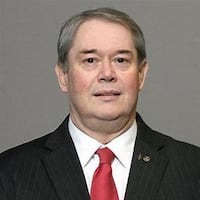The county is currently constructing a new $56.6 million jail and sheriff’s office facility that is projected to open later this year. The new jail will have nearly 500 beds compared to the current facility that has 280 beds. A five-year, 0.25% county sales tax is covering about $50 million of the construction costs.
VSWC Architects of Mason made the presentation of five options that included:
- A renovation of the 12,500 square-foot current building and demolishing that old section of the former jail at an estimated cost of $3.88 million;
- Building a new 17,000 square-foot facility where the building holding the gun range is located at an estimated cost of $5.09 million;
- Building an 17,00 square-foot addition on the other side of the Board of Elections/Prosecutor’s Office building and the Common Pleas Courthouse at an estimated cost of $5.75 million;
- Building an 17,373 square-foot addition to the Common Pleas Courthouse and extending the wing where the Domestic Relations Court is located at an estimated cost of $5.26 million; the building was master-planned for an addition, but would block a future expansion of the a General or Domestic Relations courtroom.
- Building a separate 18,338-square-foot building between the Common Pleas and Probate/Juvenile courthouses at an estimated cost of $5.08 million. It would also facilitate a future expansion if needed.
Representatives from VSWC Architects reviewed the various options but the commissioners were interested in concepts that would allow for future expansion as the county continues to grow.
The final “Option E,’ a new court facility with future expansion possibilities was the option that commissioners seemed to like the best. Trevor Hearn, facilities management director, said people go to the wrong court building all the time and this option would also preserve space for a future expansion of Common Pleas Court. He said this would put all three court houses on one end of the campus.
County Court Judge Gary Loxley said he and fellow County Court Judge Robert Fischer supported any renovation or a new building for the court. However Loxley said their preference would be “Option E.”
“(Options) B, C, D and E are better than ‘Option A’ (the renovation concept),” he said. “We inherited a building not designed as a court.”
Commissioner Tom Grossman liked “Option E” and suggested building a two-story building now and leaving the second floor unfinished for future expansion. Hearn said a single-floor building would be better to comply with the Americans with Disabilities Act.
Commission President David Young agreed with “Option E” and that it would be cheaper to do the pre-work now. He agreed that separate facilities make sense.
Commissioner Shannon Jones agreed with “Option E” and added there needs to be a conversation about a master plan for the Governmental Campus.
Tiffany Zindel, county administrator, said she did not want to scrap buildings. She said the current court building could be used for the county Board of Elections and use a portion of the former jail for storage. She also added that pre-trial corrections is also in need of space.
Over the past several years, there have been building projects to expand the county government campus including an addition built to the Common Pleas Courthouse; and addition to the Probate/Juvenile Courthouse and a new building housing the Board of Elections and the Prosecutor’s Office.
About the Author
